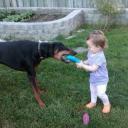Yahoo Answers is shutting down on May 4th, 2021 (Eastern Time) and beginning April 20th, 2021 (Eastern Time) the Yahoo Answers website will be in read-only mode. There will be no changes to other Yahoo properties or services, or your Yahoo account. You can find more information about the Yahoo Answers shutdown and how to download your data on this help page.
Trending News
Question about domestic dog diet?
Okay, so this is a little long, but I really think this is interesting!
Lots of people on here (myself included) frequently advocate a grain free, or particularly a corn-free diet for dogs. Many people go even further and feed raw diets consisting entirely of raw meat.
I've been taking both domestic animal physiology and nutrition classes, so I'm learning a bit about the subject. I was also reading an archaeological periodical today that brought up some questions. In searching for the origins of domestic dog, and their early relationship to humans, research suggests that the dog has been around humans for more than 15000 years. Further, in some areas and at some times dogs were companion or sacred species, and in other places or at other times they were the first and possibly the only domesticated food species. In both instances, the dominant theory of domestication is that the less aggressive individuals in the wolf pack were allowed to be near to humans, and therefore gained advantage of protection (ex: nearness to fire) and food scraps.
Now to diet- it's not likely that the food scraps consisted primarily of cuts of meat or organ, or even useful bone. Early humans subsisted largely on tubers, grains, berries and fruits, and secondarily on meat. Meat had a high skill and energy requirement, and didn't last all that long, therefore it would have been prized and very little wasted. What would be wasted were surplus grain (if any) and other vegetative refuse.
So, it's undeniable that living with humans conveyed some advantage to early dogs, or else they wouldn't be around today. It then follows that possibly this variegated diet of vegetation and bone-meat scraps was physiologically SUPERIOR to the total meat diet eaten by wolf predecessors.
Futher, in the Mississippi region of Cahokia, dogs were cultivated for meat. Interestingly, they ate diet of almost entirely corn (proven by carbon analysis of remains). Farmers would be looking for the most effective way to fatten animals for the table. If that way was corn, how is it possible that dogs cannot adequately digest corn?
Anyway, if you've seen my previous posts, I've advocated corn-free diets in the past. I'm re-thinking this opinion, and I'm curious of what people here think.
Great comments!
The thing I keep getting hung up on is that the inclusion of human waste was advantageous to dogs- not just OK. Natural selection tells us that the fittest survive. Therefore, there would have been a clear advantage to the inclusion of some vegetation or they likely would have stayed wolves.
Ava (and others): I agree that there would be other factors like protection. Food access is generally the main differentiating feature in survival though (along with size and exhibition features like plumage, which are allowed to develop because of good access to food), so I have to wonder whether that diet must have been superior rather than just "not going to kill them."
I know many dogs do better without grain (including my ACD mix), but my lab does better with. I've had his blood tested and his levels are excellent on an inclusive diet, but he loses weight on all the grain-free diets I've found. Can't figure it out, but maybe there's something to this.
Rayven: Yes, I've seen a dog GI tract- very short, shortest of all the domestic species. BUT, there is a big difference physiologically between forage and grain. Ruminants and animals with an enlarged cecum (horses, which function very similarly to ruminants, including microbial digestion of forage) require fermentation and the use of microbes to produce volatile fatty acids for energy, rather than using ketones from amino acid breakdown, like true carnivores (cats and minks). This is different from carbohydrate digestion, which is enzymatic digestion. ALL carbohydrate digestion (grains) occurs in the stomach- even in ruminants and horses, therefore the hindgut (or forestomach in the cow) is not even used for grains. Would I give my dog (or myself) forage? No, but all you need is a stomach (and a very small one- horse) to digest grain, so they really are built for carb digestion.
Sorry if I'm rambling, i think this stuff is so cool!
Ms. Manners: Very good point! I was reading something about how we are getting very low levels of Omega 3 (as opposed to omega 6, which we get a lot of) because of what we're feeding our livestock. Humans are built to take a lot of our nutrients from foraging animals- we cannot process forage, so we can't get to the nutrients in it- therefore we rely on ruminants to process it for us. since we're not feeding grains high in omega 3 to livestock (beef cattle), we're not getting it in the meat. That would follow for our dogs, too- both of our nutrition is only as good as the nutrition of the animals we eat.
Good points!
Also, yes, husbandry is very old, but not as old as the dog. I'm talking about WAY before agricultural revolution, when dogs were being domesticated. I also think they definitely got SOME meat, but the majority was going to go to humans.
♥shelter puppies rule♥: True, dogs don't have amylase in the their mouth, but they still have amylase- in the stomach and small intestine. They do have the same digestive tract as wolves- who also have amylase.
Also, I'm really just playing devil's advocate here- I don't think heavy grain diets are necessarily good for dogs, but I'm also not sure they're as evil as they're made out to be. Just bringing up points for discussion!
11 Answers
- Anonymous1 decade agoFavorite Answer
You're talking as if this is ancient history ... when for many breeds it wasn't much more than 100 years ago that "civilization" got a hold of some of these dogs.
The Samoyed - which still herd reindeer in Siberia are still eating EXACTLY what they ate 5000 years ago... meat. They still are turned loose in the summer to forage for themselves (and believe me, those who have them in modern homes know their foraging skills!). They still hunt, kill and eat small prey animals and will still gather as a group (perhaps a pack) to try to take on something larger... those same herding skills are also quite effective in running down prey... and they EAT it. There has been no "agricultural revolution" there. And there has been a push to maintain their traditional nomadic lives without even the aid of machines like the snowmobile.
In a Siberian subsistence household NOTHING goes to waste. Sure, the dogs get scraps of cooked food. They also get the slaughter parts that the humans don't want.
My grandparents had Samoyeds in the 1950s and 60s. They ran a farm with some hogs, chicken and sheep. They worked their dogs. They didn't feed kibble... they fed what dogs eat --- chicken heads, entrails, feet... during slaughter they fed everything humans didn't want from hogs and sheep... they fed venison trimmings. In the past, blood was collected sometimes for human consumption - blood pudding and black sausage - and sometimes for dog consumption coagulated blood. Then there was the fish my grandfather caught --- by the time they were filleted more than half of the fish went to the dogs - heads, skin, entrails and all.
Have you ever seen an animal butchered? There is a tremendous difference between live weight and hanging weight. There is an even bigger difference between hanging weight and what ends up in pretty packages in the freezer. The dogs get all those differences which can be up to 1/3 or more of the weight live.
Remember that historically there wasn't refrigeration. Any meat that couldn't be preserved from a big kill would rot.
Sometimes you have to realize that the whole world didn't become Western Europe.... heck, the US has barely been around 200 years and many of the aboriginal tribes were not agriculture based.
Interesting premise, just not entirely accurate.
- 1 decade ago
As everyone else has said a good question.
Even then dogs did not rely entirely on early humans for food. EASY food yes, but those early dogs still hunted, when they got the chance. Humans provided food without work when hunts failed and with any predator, the fail rate is usually larger than that of the success rate.
" If that way was corn, how is it possible that dogs cannot adequately digest corn?" Have you seen the dog digestive system? Its not built for the adequate digestion of corn, grains etc. Its short and compact. For vegetation to be properly digested requires a LONG gut tract and a huge stomach. Not to mention even then corn was not hard to grow and in large amounts. Its a fairly hardy plant and even today its cheap. Which is why the majority of cattle is fed corn based feed over grass fed. Yes it can fatten livestock up, and do it much faster than grass and other food sources can. Doesn't make it healthy or even best for the animal.
ETA: Vegetation had nothing to do with them going back to being wild canines/wolves. Proto-dogs and early dogs realized it was a good arrangement to be around humans. When they didn't hunt on their own they still had access to food. Being around fires, humans and just more numbers meant having to worry less about other predators.
And yes there is a world of difference between the quality of food then and now so there is that issues. Yes some dogs do fine with some grain in their diet. many don't and others it doesn't matter either way. There's nothing to other than the simple turn of the draw.
Why are some dogs better at processing dairy products more than others? Why are some dogs allergic to all meat cooked or raw?
Yes way back then meat was highly prized, at the same time, there would have been more than enough of a carcass after the kill had been dressed and butchered for them to feed off of. And you know just scavenging of kills from other predators.
Honestly what works fro a particular dog works for them.
- 1 decade ago
I don't think survival of the fittest can be applied here. These early wolves that were domesticated hung around human camps because tehy were weaker members of the pack, they were starving. There was something that both humans and wolves had to get out of the domestication.
So these were wolves that were weaker, more puppy-like, and prone to be easily manipulated. We can prove that now by the behavioral differences in wolves and dogs.
They would have died off if they stayed with t he pack. So the fact they survived on whatever food they were able to get, if including vegetation or other human scraps, means nothing, because it boils down to these wolves weren't meant to survive in their pack probably. There was nothing superior about the diet or about these early dogs.
Kibble wasn't invented until the Great Depression, as way to make it cheaper for dog owners to feed their dogs(if they were feeding cheap corn and whatever to behgin with, they wouldn't have invented kibble during the Depression). Man fed dogs with meat leftover from hunting and livestock prior to that. If you join the yahoo group "RawChat' and ask, they have a lot of literature they could cite to you about what the early dog's diet was.
"ALL carbohydrate digestion (grains) occurs in the stomach"
I'm sorry to sound like a know-it-all but this isn't entirely correct. Digestion for carb and plant eaters begins in the mouth with the enzyme amylase in their saliva, which dogs do not have.a dog's internal anatomy and physiology is exactly the same as a wild wolf's still.
- Aphrodite ☼Lv 71 decade ago
Like the others - I don't believe that domesticated dogs solely lived off of what their humans gave them. I'm willing to bet they weren't living inside, weren't leashed or in yards so they probably had plenty of time to roam around and scavenge for their own food. On top of that, we all know that prey drive is a very real thing in dogs - thus, I'm sure they hunted down their own small game too.
Yes, dogs may not be obligate carnivores BUT that isn't to say that feeding them grains, etc. are "healthy" for them. Just because they are living garbage disposals doesn't mean they are getting nutritional value from everything they ingest.
I still believe that the grains and fillers and gross bi-product most dog owners have been accustomed to feeding their dogs, isn't the healthiest option for them and will continue with the food I feed him - grain-free food.
Interesting question though.
ADD: Going on what Ava just posted - I also don't believe corn is going to kill a dog. I think it just an empty filler and has no nutritional value to a dog. For us there is some fibre content and some protein but I wouldn't say corn was a good replacement for other healthier grains or meat.
I to noticed a difference when I went from grains, to healthier grains and then grain-free.
- How do you think about the answers? You can sign in to vote the answer.
- anne bLv 71 decade ago
Very interesting info!
However, I doubt that the early domestic dogs were fed solely by their owners. It is much more likely that the packs lived in the community, roaming freely between the humans and the wild. They probably still did a certain amount of their own hunting and foraging, and did not depend only on the humans. Similar to how the American Indians lived with their dogs.
As far as dogs being raised solely for livestock purposes, I think that is too specific an example to be widespread and that means that not all dogs would have eaten a corn diet, only the ones who were being raised as food. Seeing that practice has not been around in our country for many centuries, it is no surprise to me that dogs are not used to a corn diet.
- ms mannersLv 71 decade ago
I think its worth mentioning that until the late 1800s, neither people nor animals ate the overprocessed, vitamin- free grains that we have today. Untill roller milling was invented everyone ate more nutritious whole grains.
So the processed corn meal and corn gluten that are now a big part of cheap dog foods did not exist for thousands of years. Not to mention that corn is an American grain, and was not part of any African or European diet until its discovery in the 1500s.
Soy was not a big part of most peoples diet either, until the 1800s.
I dont know when food-coloring became popular. :o)
So....the ingredients for what passes for cheap dog food these days were NOT around for thousands of years.
I also dont see how you can assume that early peoples refuse did not include meat or bones. Many people subsisted as hunter/gatherers, and they primarily ate meat. When you find archeological digs, you usually find animal bones. In the artic (think Husky), the diet is ENTIRELY meat. Even people in agricultural areas ate cows, sheep, goats, and fish.....animal husbandry goes back thousands of years.
If you look at dogs in third world countries I think you see more of the relationship that their predecessors likely had with humans. These dogs hunt for themselves, as well as scavenging from humans. Humans do not provide the dogs entire diet, as they do in our society.
I would disagree that these dogs diet is necessarily superior to that of the wild canids. I would argue that it is simply more available. An animal that does not have to put all its effort into hunting will simply expend fewer calories, and is more likely to survive. It will not necessarily be more healthy.
*****
Before the agricultural revolution people hunted, so there would have been MORE meat in the diet, not less (think native Americans). Grain did not become a large part of peoples diet until the advent of agriculture.
Source(s): lots o dogs - Ava GirlLv 51 decade ago
Very interesting. I always enjoy reading new things regarding all sides of a common argument.
I'm assuming the early dogs gained more advantage based upon the assistance they received in living with man, as opposed to 100% fending for themselves in the wild. That's just an assumption.
The other example... I do think that dogs can digest corn. Dogs all over the world eat corn based foods & don't keel over. I've never believed it was an issue of digestion, rather something that is not the ideal basis of a diet for a dog.
I feed corn free because a dog I owned in the past had skin issues eating corn based kibbles. Those issues completely cleared up after switching to corn free foods. That proof was all I needed.
Upon my switching to corn free, other friends of mine whose dogs had skin problems followed my example & they too saw a difference in their dogs.
I base what I do more on personal experiences rather than hear say. That's me.
- 1 decade ago
I see dogs and non-obligate carnivores and cats as obligate carnivores meaning that if they were starving, and someone put out a bowl of corn, the dog would eat it, the cat would die of starvation.
I do not believe that the diet of dogs living with humans contributed to their survival versus dogs in the wild. They lived with the humans, which offered protection, when then extended lifespans. Can a dog live off of grains alone? Of course! But it isn't the healthiest option. I don't think they were physiologically superior in any way.
As for the dogs cultivated for food being fed corn...I feel there just wasn't science behind this. THey had no clue. People can't adequately digest corn either...but you can survive off of it. I think they were applying the logic of cows to dogs.
I will stick to my grain free diet for my dogs.
Good question though. Very interesting.
ETA; I wouldn't consider the addition of corn in commercial diets as "evil" just unnecessary. If I'm paying the same price for a bag of Science Diet or Iams as I am for a bag of Blue Buffalo Wilderness, I'm paying the same for a grain that my dog doesn't need and can't properly digest.
Many dogs have lived for years on corn based diets. People also used to smoke before they knew it wasn't good for them. The science is there now to show the benefits and/or risks.
- 1 decade ago
A corn free diet is best for dogs who are allergic to it but not all dogs are. But if they are allergic to it then why stop feeding it to them.
While reading this book I have on Holistic health it had a Domestic diet it didn't have corn or any other fillers in it but it looked more like a BARF diet to me.
I try and keep as much corn out of my dog diet as i can. Right now they are eating a mix of raw,kibble and grain free wet. Once i get the money they will just be on Raw and grain free because they have allergies. One has Seborrhea and the other has Atopy.
Add: my Labrador mix has the Atopy and it makes him miserable but raw has changed his scratching so has the grain free food. So i think maybe he had a bit of a food allergy but to what i don't know. But even eating the kibble(purina) he doesn't seem to scratch as much as he used to.
- 1 decade ago
It is said the dogs were of help to the humans back then and actually brought large animals down and helped feed THEM.The dogs were rewarded with the carcass while man ate what they could the dogs were given the rest.,That is how they cohabitated and brought them into their lives..








